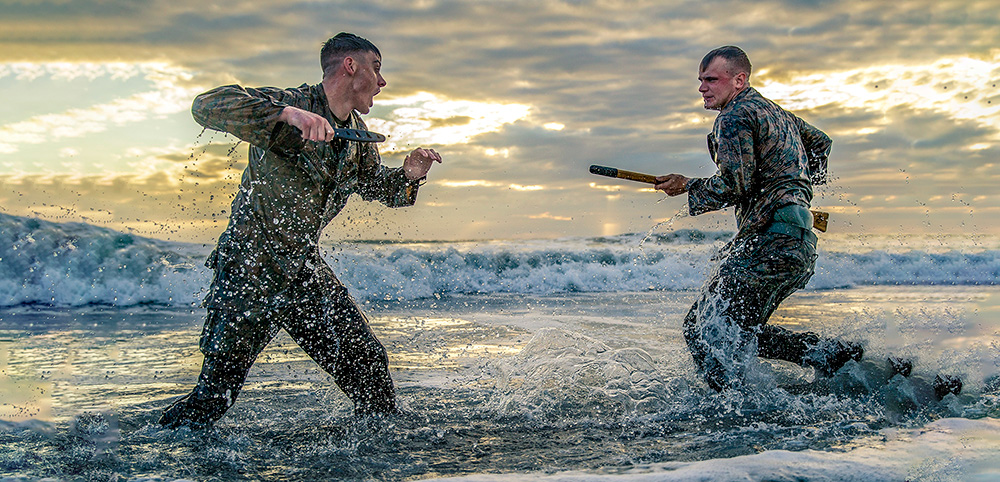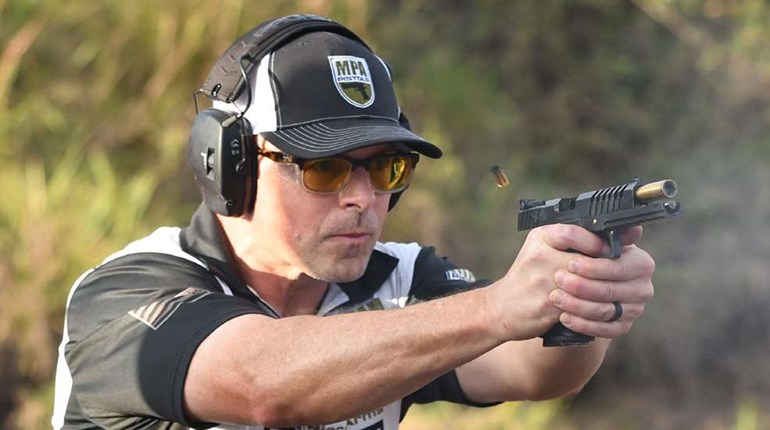
The purpose of self-defense is to be prepared for and effectively manage a real-world physical threat with the desired and beneficial outcome of maintaining a 360-degree envelope of protection around yourself and those for whom you are responsible. To help accomplish this paramount objective, there are many non-firearm defense options available, ranging from your bare hands to the usage of stun guns, pepper sprays and other projectile-launching systems other than a firearm. What are the pros and cons of each, specifically, compared with a ballistic use of force? The answers may surprise you.
Looking at it from a 30,000-foot perspective, the overall umbrella of self-defense begins with the contrast between “rules of engagement” (ROE) that govern U.S. military operations and “use of force” (UOF) policies that apply from a legal standpoint to U.S. civilian law enforcement and citizens alike.
Rules of engagement are the overarching directives that delineate the circumstances and limitations for initiating or escalating direct military action involving the use of force. Importantly, ROEs account for the chaotic, high-intensity environments of armed conflict. They are intentionally more permissive when it comes to using offensive force against enemy combatants than civilian law enforcement is legally allowed. The overriding priorities are accomplishing the military objective and protecting one’s forces.
In stark contrast, law enforcement’s UOF regulations exist within a vastly different context, that of preserving public order and judicially apprehending criminal suspects while operating amongst innocent civilians. Policies on UOF draw their legal and philosophical basis from the reasonableness standards set by the Fourth Amendment protection against unreasonable search and seizure.
As opposed to offensive military action, police UOF policies authorize only the amount of defensive force reasonably necessary to safely control a situation, make an arrest or protect themselves and others from harm. Lethal force is permitted only when the officer has probable cause that a suspect poses an immediate threat of death or serious bodily harm.
We, as law-abiding citizens of a free republic, are bound by the same rules and regulations governing application of appropriate use of force minus the peace officer’s responsibility to enforce the law.

Per the rule of law, civilians may only apply that amount of defensive force reasonably necessary to protect themselves and other innocents from harm. Lethal force is appropriate only when faced with an immediate threat of death or serious bodily harm. The concept of self-defense options enters the equation when considering the gamut of less-lethal to lethal use of force.
Commonly known less-lethal self-defense options range from hand-to-hand combat to using handheld self-defense tools such as edged weapons, impact weapons, flexible weapons, stun guns, pepper sprays and pepper-based projectiles.
What most people fail to realize is that physical violence doesn’t just materialize out of thin air. There are almost always observable events that occur leading up to physical violence—a gradual progression of human aggression—precursors to physical violence, which can be observed, influenced and even prevented.
Viewing the entire self-defense spectrum, which can range from a potential threat to one that develops into a violent physical assault, allows you to identify and apply two lifesaving skill sets that can be used at work, at home and elsewhere: one for managing physical violence, referred to as reactive measures, and the other for managing those events leading up to physical violence, referred to as proactive measures.
Failure to notice and prevent a series of events from evolving into physical violence relegates you to the application of reactive measures. These are hard skills where you must use your body, introducing the potential for physical injury.
Any non-physical skills used to predict, prevent or otherwise control a series of events from escalation to physical violence are referred to by the professionals as soft skills, where you use your mind, precluding you from bodily injury.
Soft skills are gained by awareness-based training, which include applying your awareness and knowing how to collect and process data from your environment. Unlike hard skills, which require training your body, soft skills are not physical and do not require any physical training.
When it comes to threat management, these two lifesaving skill sets are not equal. Hard skills are reactive measures, whereas soft skills are proactive measures. You can be trained in soft skills to observe and defeat a potential or emerging threat, versus having no other choice but to defend against it using your hard skills.
Think back to your earliest childhood memories, maybe when you were five or six years old. Now try to recall from that time to 10 minutes ago, the number of times you were involved in a violent physical altercation. Compare that with the number of times you applied your awareness or other soft skills to observe something that caught your attention, for example when you were driving and observed someone swerving on the road next to you. What percentage of the time would you say you’ve ever applied your hard skills over the span of your lifetime? What percentage would you say you applied your soft skills over the span of your lifetime?
Presenting this same question to thousands of people who have participated in my professional training programs over the span of three decades resulted in the answer of 98-percent soft skills and 2-percent hard skills used. Are your percentages about the same? Do you believe that these percentages are likely to change in the future?
The purpose of self-defense is to be prepared for and effectively manage a real-world physical threat with the desired and beneficial outcome of maintaining a 360-degree envelope of protection around yourself and those for whom you are responsible.
The better your soft skills, the greater your odds of problem solving by staying ahead of the action-reaction power curve and avoiding bodily injury. Chance favors the trained. The more you use your soft skills, the lower the likelihood of needing your hard skills.
Failing to apply your situational awareness or other soft skills to resolve the situation early on, you are then relegated to one of only three options. The first and most effective option, without exception, is to run away. Get yourself out of the situation by creating distance. Distance is your friend. More space equals more time, which equates to more opportunity to solve the tactical problem.
The second option is to surrender to your attacker(s) and the third is to fight your way out of it by using reactive measures—aka applying appropriate use of force (AUOF).
As we are free to choose, but we are not free from the consequences of that choice, the decision to apply AUOF invites the likelihood of incurring physical injury. Your AUOF options range from using your bare hands to a handheld self-defense tool.
It sometimes surprises people when I share with them a stark reality that when it comes to self-defense options, there are only two types of people in the world—those who are trained and those who are untrained. Fortune favors the trained.
If you attempt to use any form of physical-defensive tactics and do not have the training to effectively apply it, then those tactics may very well be used against you by those who may be better trained, have more street savvy and/or may be physically stronger, quicker or in better shape than you.
If you elect to go the hand-to-hand route, then you must have a minimal set of hard skills to include the martial arts like boxing, Muay Thai, Brazilian jujitsu, Krav Maga and the like. If you elect to use a non-ballistic, close-quarters defensive tool, such as a knife or an expandable baton, then you would need to have requisite training on board from, say, the Filipino martial arts or equivalent. If not, then that knife or baton may very well end up being used against you.
Improvised self-defense options such as a length of rope, purse strap, handkerchief, etc., (aka flexible weapons), a screwdriver, handheld flashlight and the like, all of which are viable AUOF options, also require some level of proficiency training.
While law enforcement has widely adopted “conducted electrical weapons” like stun guns and Tasers, their civilian usage can be restricted and, in some circles, considered controversial. These incapacitating devices, which temporarily overload the body’s muscular and sensory functions using electrical impulses, are legally possessed by civilians at the federal level. Uncle Sam allows both stun guns and Tasers to be purchased and owned by civilians for self-defense purposes.
While not legal in some jurisdictions for reasons that are difficult to comprehend, stun guns and Tasers are relatively unregulated for civilian use in most localities. Some of these “stun-gun permissive” states extend broader legal protections and freedoms for civilians to purchase, carry and use the devices without needing special licenses or training. Case law is still evolving around acceptable legal use and self-defense claims.
Proponents of civilian-stun-gun ownership argue they are empowering self-defense tools, especially for vulnerable demographics like women, the elderly or those with physical disabilities. With basic training, they allow a weaker individual to fend off larger, stronger assailants through less-lethal, electrical incapacitation rather than resorting to lethal use of force.
Appropriate training educates owners on use of force laws, properly identifying threats, de-escalation tactics and safe device-handling procedures. While not a panacea for physical violence, stun guns and Tasers have empowered civilians with an effective self-defense option.
Small, handheld pepper-spray canisters dispense an aerosol irritant made up of oleoresin capsicum (OC)—the oil extract that gives chili peppers their pungent, inflammatory burn. Easy to conceal yet surprisingly potent, OC sprays are legal for purchase and possession by civilians in all 50 states, though some municipalities—typically large, urban areas—have usage restrictions.
Acting as an intense irritant to the eyes and respiratory system, pepper spray causes temporary blindness, a choking sensation, uncontrollable coughing and a general loss of muscle control, usually for around 30 to 45 minutes. This buys victims time to escape an assailant. Reasonably priced and easy to carry, it has now become one of the most ubiquitous self-defense tools for people living or working in high-risk areas.
Fired from handheld launchers, pepper balls are moderate-velocity projectile rounds filled with powdered OC irritants. Upon impact, the lightweight plastic balls burst and create an expansive aerosol cloud of the inflammatory capsicum. The peppery mist causes all the same uncontrollable burning and debilitating effects as sprays, but over a broader area and at longer ranges.
At their core, these inflammatory deterrents provide normal citizens access to powerful tools to repel aggression, create distance and escape attackers through forceful and unpleasant sensory overload. However, as with any other self-defense option, training and practice are strongly recommended prior to everyday carry (EDC).
When it comes to self-defense tools, including a firearm, the greater the range, effectiveness and capability of a weapon in stopping or mitigating a physical attack, the greater the restrictions and legislation and the greater amount of training required. This is not by coincidence.
Nobody wants violence, but unfortunately our world has yet to evolve to the point where it has been eradicated. You can click on the news and find daily reminders that violence is very much a part of our society. As long as this remains the case, there will always be the need for lethal and less-lethal self-defense options.




































